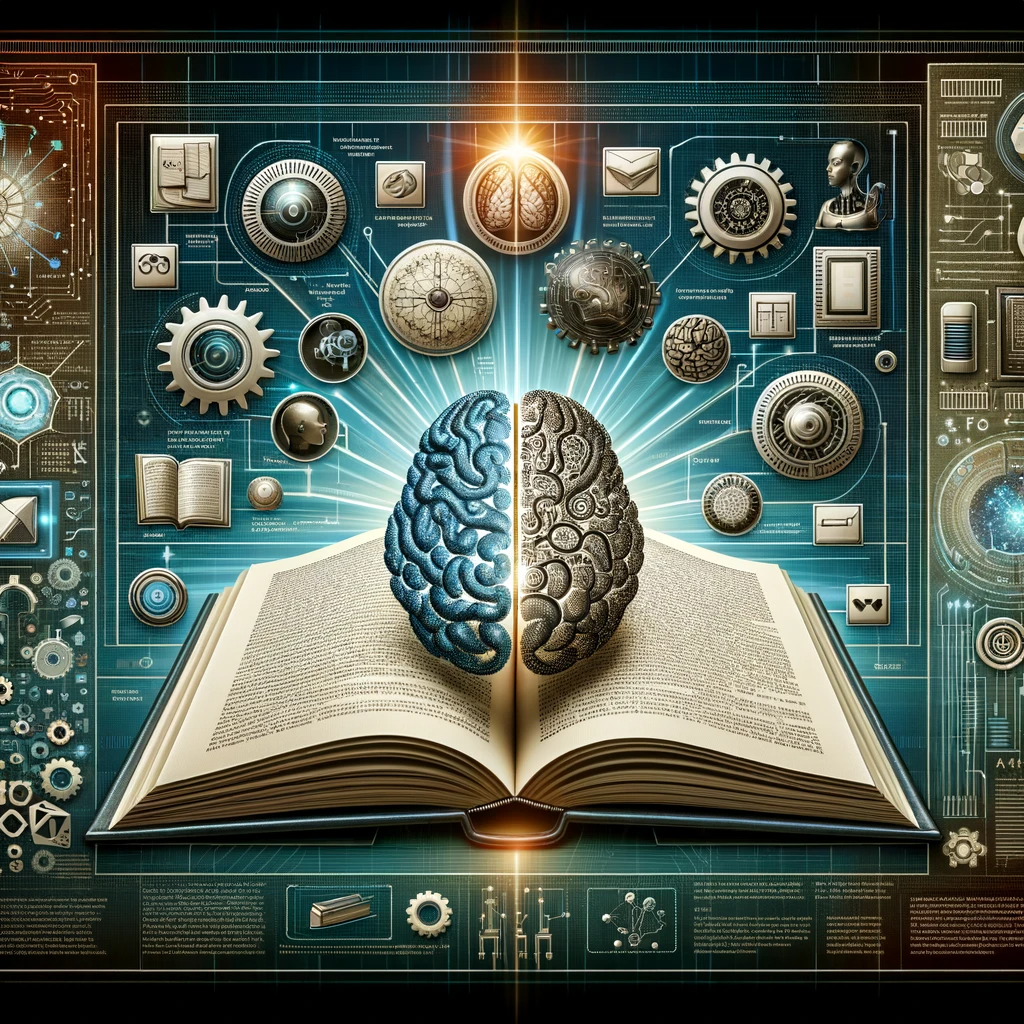Artificial Intelligence (AI) has emerged as a pervasive and transformative force in recent years, capturing the imaginations of many and influencing numerous industries. Despite its growing prominence, AI often remains a complex and enigmatic subject for those unacquainted with its inner workings.
In this extensive exploration, we aim to demystify AI and bridge the divide between its intricate nature and comprehensibility. By delving into its definition, historical evolution, operational mechanisms, applications, ethical considerations, and future prospects, we aspire to provide you with a comprehensive understanding of this revolutionary technology.
Understanding the Foundations: The Definition and Types of Artificial Intelligence

At its core, Artificial Intelligence seeks to replicate human intelligence within machines, endowing them with the capacity to think and learn as humans do. This emulation encompasses various cognitive functions, including problem-solving, natural language comprehension, pattern recognition, and data-driven decision-making. AI systems aspire to mimic human intelligence, empowering them to execute tasks that traditionally require human cognitive abilities.
AI can be categorized into two principal types:
- Narrow or Weak AI: These AI systems are engineered to perform specific tasks or solve distinct problems proficiently. While they excel in their designated domains, they lack the capacity for generalized intelligence. Examples encompass virtual personal assistants like Siri, image recognition software, and chatbots.
- General or Strong AI: General AI represents an advanced form of AI with cognitive capabilities akin to those of humans. It possesses the ability to understand, learn, and apply knowledge across a wide spectrum of tasks, mirroring human versatility. However, it’s essential to note that the realization of General AI remains largely theoretical and has not yet been achieved.
AI’s Evolution: From Complex Ideas to Clear Innovations
The roots of AI can be traced back to ancient history, where early attempts were made to create mechanical devices mimicking human actions. However, the terminology “Artificial Intelligence” was officially coined in 1955 by John McCarthy, an American computer scientist. The field of AI began to gain substantial momentum during the mid-20th century.
In the 1950s and 1960s, AI researchers primarily concentrated on symbolic AI. This approach entailed programming computers to manipulate symbols and engage in logical reasoning, eventually resulting in the development of early AI systems such as the Logic Theorist and General Problem Solver.
The subsequent decades, particularly the 1970s and 1980s, witnessed the emergence of expert systems. These AI programs were meticulously designed to replicate human expertise within specific domains, leading to their extensive utilization in fields such as medicine and finance.
The 1990s marked a pivotal shift in AI research towards machine learning and neural networks. This era witnessed substantial advancements in AI, particularly in the realms of natural language processing and computer vision.
In recent years, AI has made astounding progress, propelled by developments in deep learning, the abundance of big data, and enhanced hardware capabilities. These advancements have facilitated the integration of AI applications into our daily lives.
Deciphering the Machinery: A Closer Look at the Inner Workings of AI

Fundamentally, AI operates on the foundational pillars of data and algorithms. Here is a simplified overview of how AI functions:
- Data Collection: AI systems necessitate copious amounts of data to learn and make informed decisions. This data can be either structured, such as databases, or unstructured, encompassing text, images, and audio.
- Data Preprocessing: Prior to inputting data into AI algorithms, it often undergoes cleaning, transformation, and organization to eliminate noise and inconsistencies.
- Machine Learning: Machine learning constitutes a subset of AI where algorithms are trained on data to make predictions or decisions. This process entails discerning patterns and relationships within the data. Common machine learning techniques encompass regression, classification, clustering, and deep learning.
- Training and Testing: During the training phase, AI algorithms learn from the data and adjust their parameters to minimize errors. Subsequently, testing is conducted to assess the model’s performance on new, previously unseen data.
- Inference: Once trained, AI models can generate predictions or decisions based on newly inputted data. For instance, a trained image recognition model can discern objects within a photograph.
- Feedback Loop: AI systems continuously enhance their performance over time by continually learning from new data and user interactions. This feedback loop is pivotal in refining their accuracy and efficacy.
Transforming Industries: The Pervasive Impact of AI Across Sectors

AI has exerted a profound influence across a diverse array of industries, ushering in transformative changes that redefine how we live and work. The following are notable examples:
- Healthcare: AI is instrumental in medical image analysis, disease diagnosis, drug discovery, and the creation of personalized treatment plans. Additionally, AI aids in predicting disease outbreaks and managing patient data, significantly improving healthcare outcomes.
- Finance: AI-powered algorithms are increasingly utilized for stock market predictions, fraud detection, credit scoring, and algorithmic trading, reshaping the financial landscape.
- Transportation: Self-driving cars and drones leverage AI for navigation and collision avoidance, enhancing safety and efficiency. AI also plays a pivotal role in optimizing traffic management systems, alleviating congestion.
- Entertainment: AI is integral to content recommendation systems on streaming platforms like Netflix. It also contributes to the generation of computer-generated imagery (CGI) in movies and video games, elevating the quality of entertainment experiences.
- Customer Service: Chatbots and virtual assistants driven by AI provide automated customer support and streamline communication with customers, delivering efficient and responsive service.
- Agriculture: AI is harnessed for crop monitoring, yield prediction, and precision farming, revolutionizing agricultural practices by optimizing resource allocation and crop management.
- Education: AI-driven personalized learning platforms adapt to the individual needs of students, offering tailored educational experiences that enhance learning outcomes.
- Natural Language Processing (NLP): NLP models such as GPT-3 have the capacity to generate human-like text, facilitating applications such as automated content creation, language translation, and sentiment analysis, transforming the way we communicate and interact with technology.
Navigating the Moral Compass: Ethical Challenges in the Age of AI

While the potential benefits of AI are immense, they are accompanied by significant ethical concerns that necessitate careful consideration and mitigation:
- Bias and Fairness: AI systems can inadvertently inherit biases present in their training data, leading to discriminatory outcomes. Addressing bias and ensuring fairness in AI algorithms is a critical ethical challenge, demanding ongoing vigilance and corrective measures.
- Privacy: The collection and analysis of personal data by AI systems raise substantial concerns pertaining to individual privacy and data protection. Striking a balance between fostering innovation and safeguarding privacy is imperative.
- Accountability: Determining liability when AI systems make errors or cause harm can be a complex matter. Establishing clear lines of accountability is paramount to address potential consequences and liabilities arising from AI applications.
- Job Displacement: As AI automation advances, concerns surrounding job displacement in specific industries become increasingly salient. Preparing the workforce for AI-related changes through reskilling and upskilling initiatives is a pressing societal challenge.
- Security: AI systems can be vulnerable to various forms of attacks and manipulation. Ensuring the security of AI systems is essential to prevent potential misuse, safeguarding both individuals and organizations.
- Autonomy and Control: The question of the autonomy of AI systems and their potential to make critical decisions independently, without human intervention, is a topic of ongoing debate. Establishing boundaries and safeguards for AI autonomy is essential to prevent unforeseen consequences.
The Future of AI: Balancing Complexity with Promising Clarity
The future of AI holds boundless promise, with numerous trends and developments poised to reshape our world:
- Continued Advancements in Deep Learning: Deep learning, a subset of machine learning, will continue to propel AI forward, enabling increasingly sophisticated applications and systems.
- AI in Healthcare: AI’s role in healthcare is set to expand significantly, encompassing areas such as drug discovery, telemedicine, and patient care, contributing to more accurate diagnoses and improved treatment outcomes.
- AI for Climate Change: AI represents a potent tool in the fight against climate change. It can optimize energy consumption, predict natural disasters, and analyze vast datasets related to environmental trends, facilitating informed decision-making and sustainability efforts.
- Human-AI Collaboration: The future of AI is not about replacing humans but collaborating with them. AI will enhance productivity and decision-making across diverse domains, amplifying human capabilities rather than supplanting them.
- Quantum AI: The convergence of quantum computing and AI promises breakthroughs in solving previously intractable problems, unlocking new frontiers in science, medicine, and industry.
- AI Regulation: Governments and international bodies are likely to introduce regulations to ensure the ethical and responsible use of AI, safeguarding against potential misuse and harm.
Conclusion
Artificial Intelligence stands as a transformative technology poised to reshape industries, enhance our quality of life, and address pressing global challenges. While AI may appear complex and mysterious, it fundamentally operates on principles rooted in data, algorithms, and learning mechanisms. Its applications span a wide array of domains, from healthcare to finance to entertainment, fundamentally altering the landscape of these industries.
However, the ethical considerations surrounding AI are of paramount importance. Ensuring fairness, privacy, accountability, and security in AI systems is essential to harness the benefits of this technology while mitigating its risks and potential harm.
The future of AI is characterized by ongoing advancements, burgeoning human-AI collaboration, and the potential to tackle some of humanity’s most significant challenges. As we journey forward, it is crucial to strike a delicate balance between harnessing the immense power of AI and addressing its ethical and societal implications. AI, ultimately, is a tool, and the manner in which we utilize it will define its impact on our world and the generations to come.







